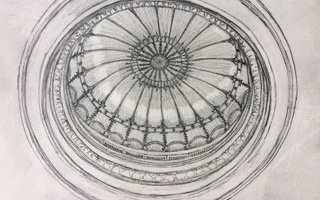I am a firm believer in the idea that visual landscapes disclose the culture of a community.
Harvard Yard is a space of hustling and bustling. Walk through its green spaces on a Friday afternoon and you’ll see a community coming together around spike ball, picnic blankets, and lively conversations. Cross the gates on the far end of the Yard and you will be met by Memorial Hall and the Science Center side by side, juxtaposing our University’s roots in tradition with its commitment to modern scientific discovery. These are snapshots of Harvard reflected in our physical spaces.
Now let’s do a quick scavenger hunt: find all of the physical spaces on campus that are dedicated to fostering inclusion and belonging for students from historically marginalized communities. The Women’s Center, the Harvard Foundation, the Office for BGLTQ Student Life, Harvard Hillel, the Canaday Musallah. You’ll quickly come to realize that all but one of these spaces are located underground, hidden from plain sight. Meanwhile, walk down Mount Auburn St. on a Saturday night and the presence of final clubs is inescapable. Their buildings, two or three stories tall, tower over you in comparison.
If the physical landscape of Harvard reflects our community’s commitments, then this picture is a troubling one. While students of color, queer students, women, and other historically marginalized communities are symbolically relegated to basements, the image of old Harvard—one defined by exclusivity, masculinity, wealth, and whiteness—dominates. Even as our Harvard makes broad leaps away from its ugly past by admitting one of its most diverse classes, showcasing its diversity on the main stage of Sanders Theatre, and embracing female leadership, our physical spaces remain stagnant. Crop out the students, workers, faculty, and staff and our Harvard still looks like old Harvard.
Physical space is vital, not just because it reflects our commitments, but also because the environment we inhabit and regularly interact with necessarily impacts our experiences in and feelings towards that space. In conversations and surveys, students from historically marginalized communities consistently report lacking a sense of belonging at Harvard. On paper, this seems innocuous. But as someone who struggles deeply with belonging in this community, I cannot overstate how all-encompassing this feeling has been for me. In sections, in Undergraduate Council meetings, at office hours, and in the dining hall, I have to work two or three or four times as hard to make my presence felt in spaces that weren’t built for me.
Because my time at Harvard has so far been defined by my efforts to carve out a space for myself and people like me on this campus, I’ve had little time left to explore my interests, pursue my passions, be a student, or even just sleep. These feelings are not mine alone: I hear these sentiments daily from my friends, people I work with, and acquaintances in passing.
So what is the solution? How can we foster more belonging on campus for students whose identities have been historically and systematically excluded? I can’t pretend to know the antidote to such a deep-seeded problem. However, I echo the sentiments of Harvard Business School professor Frances Frei when she writes: “if Harvard is going to include people from diverse backgrounds, and they’re each to feel they belong, the physical infrastructure has to reflect their presence on campus.” A physical space for diversity, belonging, and inclusion on this campus is a crucial step forward.
This is not a novel idea. Harvard has seen advocacy for a Multicultural Center for over 40 years now. Peer institutions and colleges throughout the nation have recognized how essential such a physical space is for fulfilling their mission of creating a welcoming campus community for all. And when presented with a referendum asking if Harvard College should create a sufficient physical space dedicated to fostering diversity, belonging, and inclusion on campus, more than half of the voters in the most recent UC election answered with a resounding “Yes”.
Moving forward, the Undergraduate Council will be tasked with creating a policy statement in response to the results of this referendum. I, along with several other members of the UC and the broader Harvard community, will be drafting this statement. Our top priority has been and will be fielding input and feedback from the community at large. And when the time comes for administrators to make a decision on whether or not this is a project they will get behind, I hope all of us can meet at the table with open minds and a willingness to think creatively to envision the ideal solution.
Even if a physical space is built and our community’s commitments reaffirmed, the work to create a more inclusive community for all will hardly be done. Institutional change takes time. None of us who are currently enrolled at the College will likely see this space before we graduate. But when I envision Harvard 40 years from now, I see a visual landscape that reflects the diversity of its community. I see students from historically marginalized communities thriving in that landscape. And I see the proposed space as a central part of that community. Let’s build it together.
Salma Abdelrahman ’20 is a Sociology concentrator in Leverett House and an Undergraduate Council representative.
Read more in Opinion
All Liberalism and No Play Makes Jack a Dull Boy















